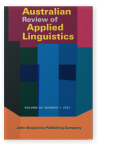Vol. 44:1 (2021) ► pp.82–108
Repetitive bundles in Malaysian learner writing
One way to investigate learner writing is by analyzing the most frequently recurring sequences of words, that is, lexical bundles. This paper presents results for lexical bundles analyses of a Malaysian corpus (MCSAW) against its reference language variety, LOCNESS (Louvain Corpus of Native English Essays). Key 4-word lexical bundles are firstly investigated in terms of their frequencies as well as distribution in both corpora. Following this, key lexical bundles are further categorized and analyzed according to their functions, including qualitative analysis of the most recurrent bundles by examination of concordance lines. Results show that learners use simple types of lexical bundles repeatedly compared to their native speaker counterparts. Evidence of tautology can also be found in learner writing. The findings highlight that using lexical bundles appropriately is important to achieve native-like fluency, while the absence of more varied lexical bundles in learners’ discourse may result in unidiomatic-sounding writing style.
Article outline
- 1.Introduction
- 2.Corpus linguistics and second language research
- 2.1Corpus linguistic research on learner language: A focus in Malaysia
- 2.2Functional categorization of lexical bundles
- 3.Methods
- 3.1Corpora as data
- 3.2Procedures
- 4.Results
- 4.1Key bundles and their functions
- 4.2Key bundle in context: Viewing concordances for qualitative reasoning
- 5.Discussion
- 6.Conclusion
- Acknowledgments
- Notes
-
References
